no light no colour no more
Posted: February 25, 2019 Filed under: eARTh | Tags: Aesthetics, art and science, Arte Povera, Arts, arts research, Cornwall, earth pigments, eco art, ecopsychology, Environmental art, Feeling, indigenous culture, painting, Pigment, Visual arts 2 Commentsfurther material responses to existential emergence, crisis and change
I was reminded recently, while gazing fleetingly into the shimmering turquoise green blue ocean here in West Cornwall, of my early art training based in the classical understanding of colour. colour as light. a systematic mixing together of homogenous materials to represent the colours that we observe in Nature from a set of ‘primaries’: reds, blues and yellows. no black. white in moderation. of hue.
 iron board, Praa Sands, Cornwall (Cornish earth pigments on rock) © p ward 2019
iron board, Praa Sands, Cornwall (Cornish earth pigments on rock) © p ward 2019
our perception of colour, of light and shade, and hence of depth, size, form and materiality, is sometimes explained as the processing and communication of visual information created by the reflection, refraction and absorption of light in relation to materials. working with earth pigments has revealed ‘colour’ as more than just a visual ‘scientific’ process of perception. it is more a holistic appreciation of material presence which encompasses not just colour but texture, smell and a provenance of time and place, of formation and decay, of ecology, history and Nature itself.
we may often associate earth colours with a range of browns, reds and yellows. with this latest set of paintings I have been enjoying a more subtle selection of greys, greens, mauves and whites that I have found, gathered and mixed near my home.
I could say that the stories they tell are unique expressions of their own experience that I have been privileged to bring into contemporary form, but maybe that is for you to decide…
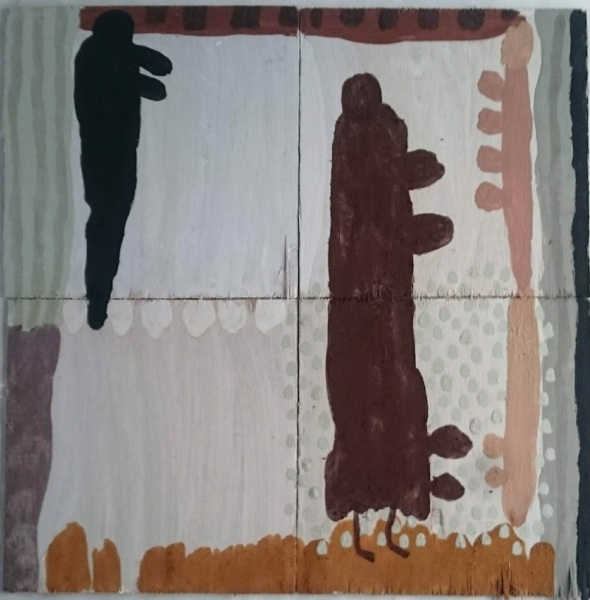 aspects of landscape and love – today it snowed (Cornish earth pigments on board; 51x51cm) © p ward 2019
aspects of landscape and love – today it snowed (Cornish earth pigments on board; 51x51cm) © p ward 2019
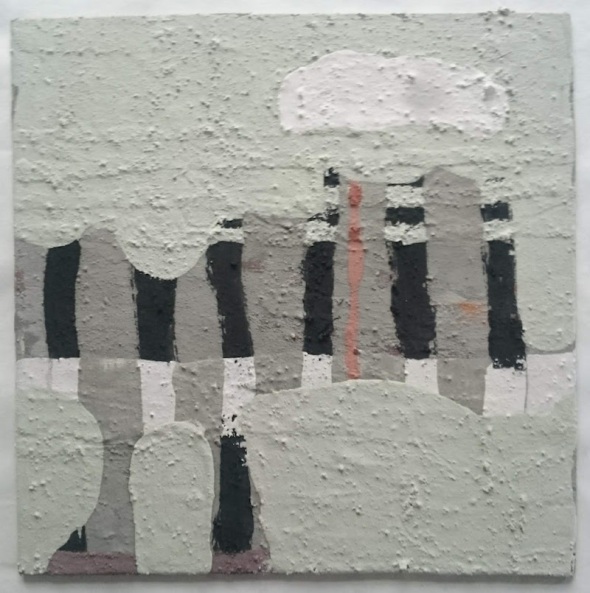 the beautiful things that people say when they are together (Cornish earth pigments on board; 25x25cm) © p ward 2019
the beautiful things that people say when they are together (Cornish earth pigments on board; 25x25cm) © p ward 2019
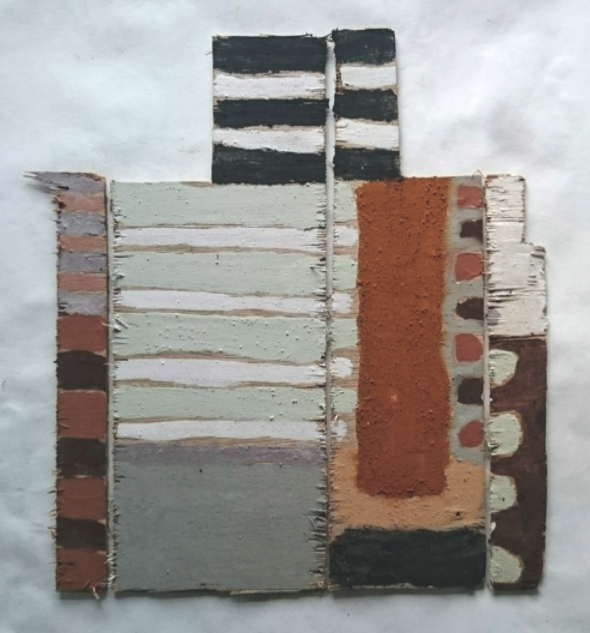 facing up to facing up to (Cornish earth pigments on board; 31x33cm) © p ward 2019
facing up to facing up to (Cornish earth pigments on board; 31x33cm) © p ward 2019
 rearranging the furniture (Cornish earth pigments on board; 35x35cm) © p ward 2019
rearranging the furniture (Cornish earth pigments on board; 35x35cm) © p ward 2019
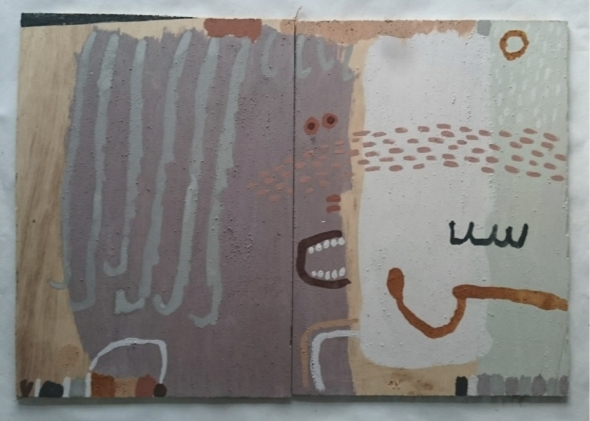 like chopping onions in a northwesterly gale (Cornish earth pigments on board; 56x38cm) © p ward 2019
like chopping onions in a northwesterly gale (Cornish earth pigments on board; 56x38cm) © p ward 2019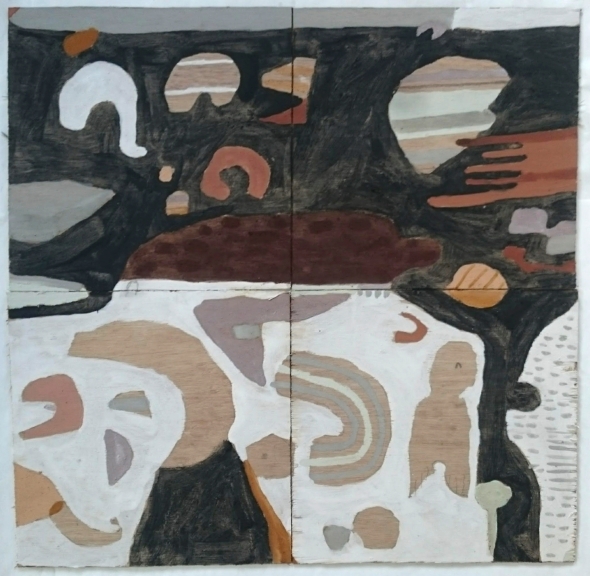 stones that stand in fields with swans and cows and geese: penwith (Cornish earth pigments on board; 70x68cm) © p ward 2019
stones that stand in fields with swans and cows and geese: penwith (Cornish earth pigments on board; 70x68cm) © p ward 2019
 simple communication here (Cornish earth pigments on card; 61x51cm) © p ward 2019
simple communication here (Cornish earth pigments on card; 61x51cm) © p ward 2019
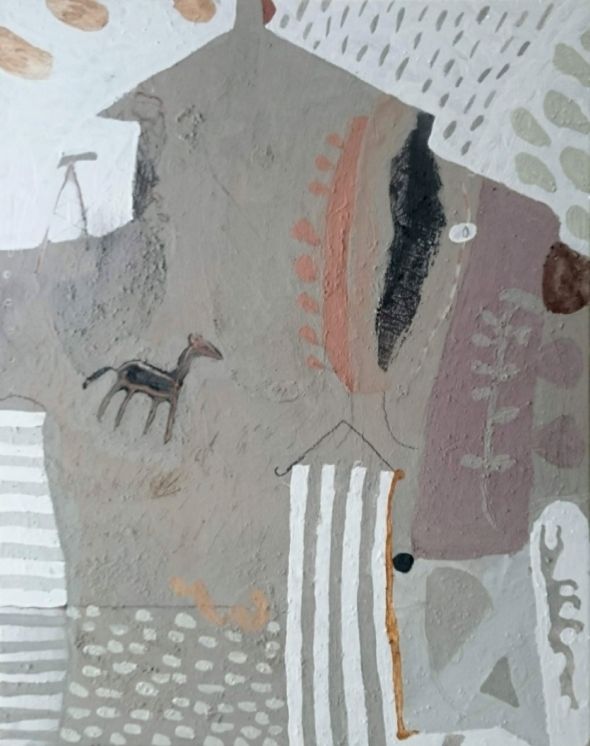 house of power (Cornish earth pigments on canvas; 40x50cm) © p ward 2019
house of power (Cornish earth pigments on canvas; 40x50cm) © p ward 2019
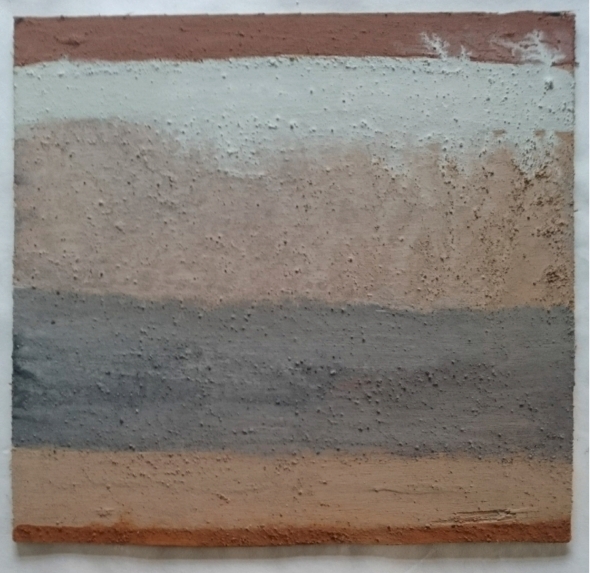 nondescript (Cornish earth pigments on board; 27x26cm) © p ward 2019
nondescript (Cornish earth pigments on board; 27x26cm) © p ward 2019
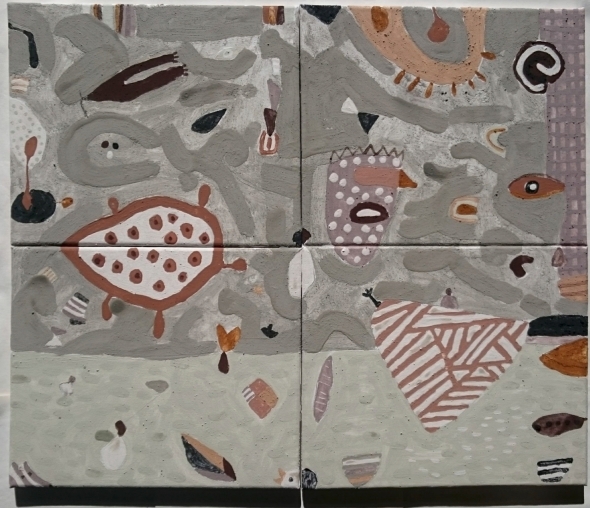 turning a new leaf with foxes on my mind (Cornish earth pigments on canvas; 61x51cm) © p ward 2019
turning a new leaf with foxes on my mind (Cornish earth pigments on canvas; 61x51cm) © p ward 2019
© P Ward 2019
painting within limits
Posted: January 26, 2019 Filed under: eARTh | Tags: Aesthetics, Arte Povera, Arts, arts research, Cornwall, Earth, earth pigments, eco art, ecopsychology, Environmental art, indigenous culture, painting, Pigment, Visual arts 1 Commentnew paintings from Cornwall – early 2019
For many years I have exclusively used colours from the earth in my paintings, gathering and processing all the pigments myself. Each location offers a unique palette and quality of colour to work with as well as a deeper understanding of that place.
To some it may seem as if creativity is being limited. “How can I paint the sky or the trees?” are frequent questions when running workshops. Working with earth pigments has changed the way I work and my understanding of painting in many ways. It has enriched my perception of colour and the ‘material’ of colour. Black is no longer “an absence of light”. For me it allows a specific expression of place orientated, of course, by my own relationship to being there.
The paintings here respond to the nature of earth colours and experiences in West Cornwall…
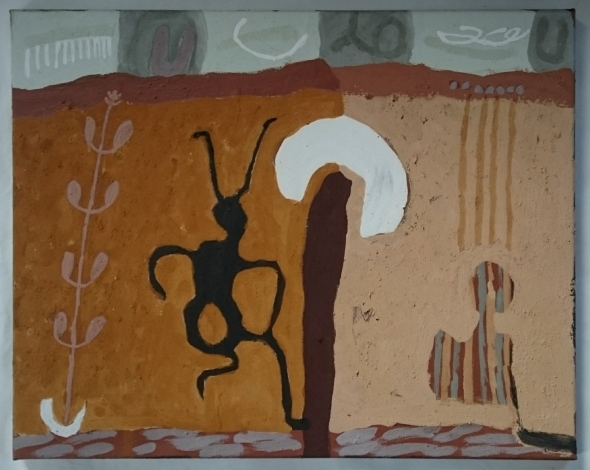 distance what we have become (Cornish earth pigments on canvas; 60x40cm) © p ward 2019
distance what we have become (Cornish earth pigments on canvas; 60x40cm) © p ward 2019
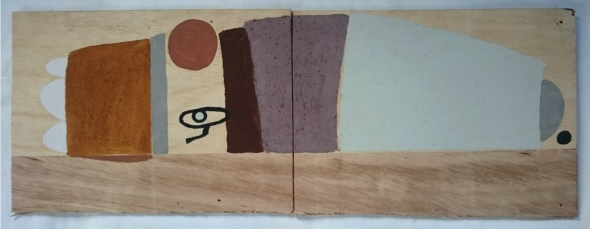 big red wolf moon that I did not see (Cornish earth pigments on board; 76x28cm) © p ward 2019
big red wolf moon that I did not see (Cornish earth pigments on board; 76x28cm) © p ward 2019
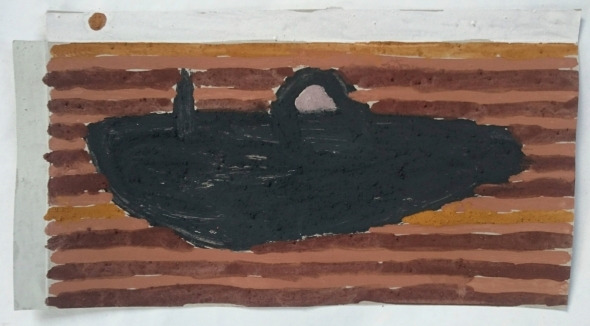 to run aground an island (Cornish earth pigments on card; 27x15cm) © p ward 2019
to run aground an island (Cornish earth pigments on card; 27x15cm) © p ward 2019
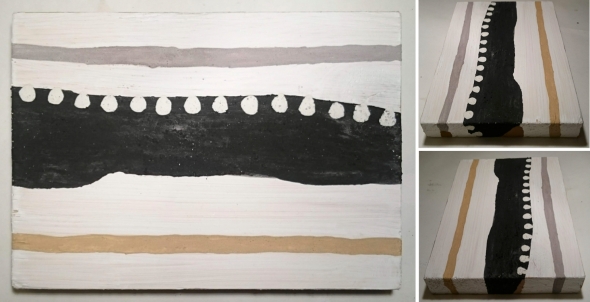 estuary (Cornish earth pigments on wood; 20×14.5x2cm) © p ward 2019
estuary (Cornish earth pigments on wood; 20×14.5x2cm) © p ward 2019
 untitled I, II, III (Cornish earth pigments on board; 25x26cm; 25x28cm; 25x26cm) © p ward 2019
untitled I, II, III (Cornish earth pigments on board; 25x26cm; 25x28cm; 25x26cm) © p ward 2019
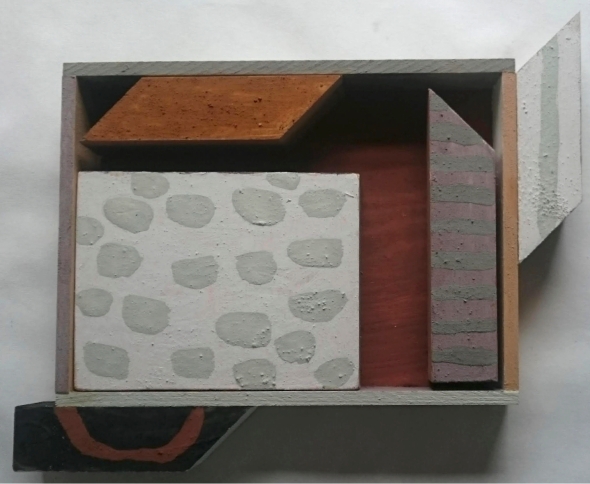 offcuts homestead (Cornish earth pigments on wood; 29x24x3cm) © p ward 2019
offcuts homestead (Cornish earth pigments on wood; 29x24x3cm) © p ward 2019
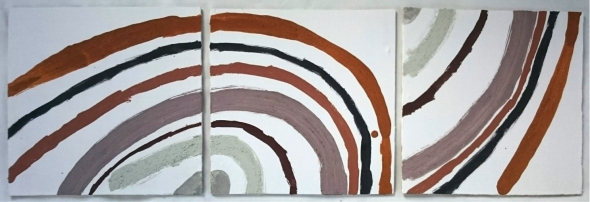 at fault (Cornish earth pigments on board; 80x26cm) © p ward 2019
at fault (Cornish earth pigments on board; 80x26cm) © p ward 2019
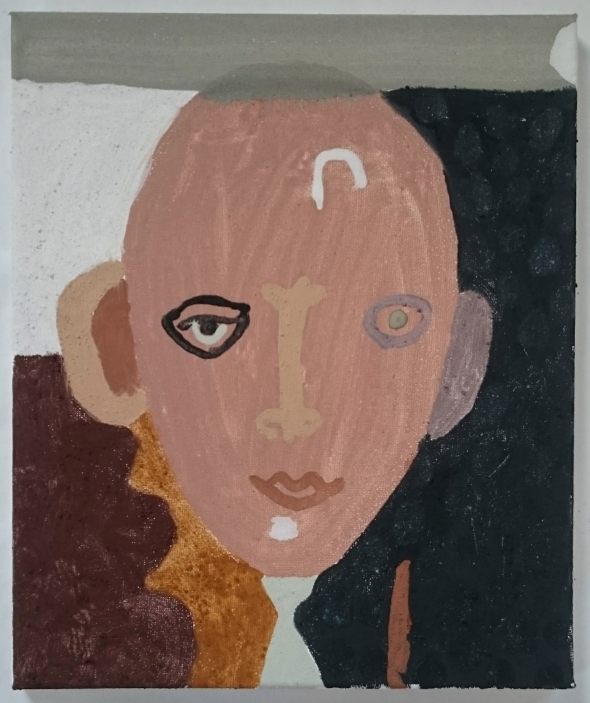 fairy queen (Cornish earth pigments on canvas; 25x30cm) © p ward 2019
fairy queen (Cornish earth pigments on canvas; 25x30cm) © p ward 2019
© P Ward 2019
coming of age
Posted: July 5, 2017 Filed under: eARTh | Tags: Aesthetics, Arte Povera, arts research, Bideford Black, Earth, earth pigments, eco art, ecopsychology, Environmental art, Feeling, Meditation, North Devon, painting, Pigment, Visual arts Leave a commentmore new paintings (and thoughts about my practice), summer 2017
“I am no longer sure of what I am doing. But then, quite simply, I am painting. I am putting together objects from materials that I gather locally, here in North Devon. Materials that are significant to me. That have stories to tell. That connect me to this place and to my being. The objects created are celebrations of this life. They are explorations. Simple, intuitive journeys of making in the here and now…” (Artist statement, summer 2017)
 burrows (earth pigments on board) © p ward 2017
burrows (earth pigments on board) © p ward 2017
At the tender age of fifty I am finding it harder to define exactly what my artwork is about. In the past I might talk about the power of art as an agent of change but no longer feel this is my main inspiration. Its power is now subtler both within my life and in the world. No longer do I work obsessively, searching for meaning and understanding – indeed my life does not allow it – but see it as a means to share my sense of wonder with the world, through both the materials I use and the approach I take to making. It is a space for myself, to come to terms with life, to find balance and peace. For whatever reason art and making has become a central aspect of my being, like a good friend. Whether this has a positive value to society as a whole I am not sure but in society, art is always there, in whatever form, quietly infiltrating the rigid constructs of our existence.
 sea wall (earth pigments on board) © p ward 2017
sea wall (earth pigments on board) © p ward 2017
However comfortable I may personally feel with my artistic practice I still feel a need (and this is where an issue/dilemma arises) to verbally justify and explain it to others, both for the sake of art historical context and as an aesthetic anchor within the art market – people seem to like to know what they’re buying into. To say that I enjoy mystery or the process seems simply not enough. Intuition is very important to me – to make, to work with the materials, until a piece ‘feels’ ‘right’ is essential to the process.
 particular I-IV (earth pigments on board) © p ward 2017
particular I-IV (earth pigments on board) © p ward 2017
To approach work not necessarily from any literal or narrative starting point, beyond the constraints of my chosen materials, but simply as an act of trust or sense of belief in the creative process and in my simple intent – to share my sense of wonder and beauty in existence. I have been slowly building my own language of marks and forms in response to the process of gathering and making paint with earth pigments. As such I feel the work is a celebration of our connection to place, and the physical matter of place, and our evolving relationship with them.
 offcuts in an offcut frame XI – factual (earth pigments on wood) © p ward 2017
offcuts in an offcut frame XI – factual (earth pigments on wood) © p ward 2017
The titles I enjoy as a poetic response to the work, often with reference to personal experience, and as a means for others to access the work.
 drawing on obscurity XII – surprise party (earth pigments on board) © p ward 2017
drawing on obscurity XII – surprise party (earth pigments on board) © p ward 2017
Politically and spiritually the work I do is significant through its lack of ‘control’, through its trust in simple processes and its respectful empathy with natural materials – it is made in mindful contradiction of the current worldview of human superiority, of ‘power over’, in denial of our supposed ability to know what is the right thing to do – we have already endangered existence through our arrogance, maybe it is time to step back a little before we create more problems. To live simply, in peace with ourselves, with others and all of existence is maybe all we can do…
 standing by the river, beneath the trees, watching rain fall (earth pigments on board) © p ward 2017
standing by the river, beneath the trees, watching rain fall (earth pigments on board) © p ward 2017
 drawing on obscurity XII – if I move slowly enough will I become a tortoise? (earth pigments on driftwood) © p ward 2017
drawing on obscurity XII – if I move slowly enough will I become a tortoise? (earth pigments on driftwood) © p ward 2017
 drawing on obscurity XIII – infiltration (earth pigments on board) © p ward 2017
drawing on obscurity XIII – infiltration (earth pigments on board) © p ward 2017
 tree (earth pigments on board) © p ward 2017
tree (earth pigments on board) © p ward 2017
Infiltration is the process by which water on the ground surface enters the soil. Infiltration rate in soil science is a measure of the rate at which soil is able to absorb rainfall or irrigation. It is measured in inches per hour or millimetres per hour.[i]
© P Ward 2017
________________________________________
[i] https://en.wikipedia.org/wiki/Infiltration_(hydrology)
please accept my resignation 131016
Posted: October 13, 2016 Filed under: activ8, eARTh, educ8, Uncategorized | Tags: Aesthetics, Arte Povera, arts research, Bideford Black, child art, collaboration, Communication, cycling, dance, Devon, Earth, earth pigments, eco art, Ecology, ecopsychology, Environmental art, Feeling, Interdisciplinarity, Nature, North Devon, North Devon Coast, Pigment, Visual arts 4 Comments
some things I have seen, done and made that have made me think, feel and smile over the last few months…
“Reading true literature [Nan Shepherd] reflected, ‘it’s as though you are standing experiencing and suddenly the work is there, bursting out of its own ripeness . . . life has exploded, sticky and rich and smelling oh so good. And . . . that makes the ordinary world magical – that reverberates/illuminates.’ ” taken from Landmarks by Robert Macfarlane.
 folded paper; little family; special gifts; friendship (earth pigments on canvas) © p ward 2016
folded paper; little family; special gifts; friendship (earth pigments on canvas) © p ward 2016
 wooden tray full of found things © eARTh 2016
wooden tray full of found things © eARTh 2016
 ‘the exmoor beast’!?, exmoor zoological gardens © p ward 2016
‘the exmoor beast’!?, exmoor zoological gardens © p ward 2016
 drawing a line, coast to coast with skedge 13916 © eARTh 2016
drawing a line, coast to coast with skedge 13916 © eARTh 2016
 learning to draw I © p ward 2016
learning to draw I © p ward 2016
 learning to draw II, III, IV © eARTh 2016
learning to draw II, III, IV © eARTh 2016
 towan beach, roseland peninsula; bottallack mines, st just, cornwall © p ward 2016
towan beach, roseland peninsula; bottallack mines, st just, cornwall © p ward 2016
 west somerset railway; bicclescombe park shed, ilfracombe © eARTh 2016
west somerset railway; bicclescombe park shed, ilfracombe © eARTh 2016
 painted palette (earth pigments on wood) © eARTh 2016
painted palette (earth pigments on wood) © eARTh 2016
 offcuts in an offcut frame – palette; mask (earth pigments on wood) © p ward 2016
offcuts in an offcut frame – palette; mask (earth pigments on wood) © p ward 2016
 figure; offcuts in an offcut frame – VIII (earth pigments on wood); building blocks © p ward 2016
figure; offcuts in an offcut frame – VIII (earth pigments on wood); building blocks © p ward 2016
with special thanks to francesca, noah, agnes, family and friends for your love, support and companionship 🙂
© p ward/eARTh 2016
a celebration 13116
Posted: January 14, 2016 Filed under: activ8, the ash tree | Tags: Aesthetics, arts research, eco art, Ecology, ecopsychology, Nature, North Devon, poetry Leave a comment.
at times
i really do not get Art
its place in my life
or the wider world around me
.
seemingly superfluous pedantic intellectual bickering
over aesthetic form and function
for some fashion or other
in the face of pressing global issues
.
not quite big enough
or loud enough
specific or far reaching enough
to make a difference
(although every whisper counts, I know)
.
 baggy point from woolacombe sands, north devon © p ward 2015
baggy point from woolacombe sands, north devon © p ward 2015
.
without it (some will argue)
life would be just an incessant instinctive struggle and movement
towards food, shelter and a mate
for nurture within our own nature
to survive within this wildness
.
and
for everybody else
this is quite enough
.
our innate beauty
our diverse evolving nature
our ecologically defined behaviour
in such abundant splendour
and complex contradiction
.
humbly seeking our place
within the heave and flow
of ever shifting forces
.
at times
I do not get art
but thank it once again
for bringing me to these conclusions
.
 new year, east clare, ireland © p ward 2016
new year, east clare, ireland © p ward 2016
© p ward 2016
art has enriched my life…
Posted: September 25, 2014 Filed under: A BUNDLE OF STICKS, activ8, BIOSPHERic, eARTh | Tags: Aesthetics, Arte Povera, arts research, Earth, earth pigments, eco art, Ecology, ecopsychology, Environmental art, indigenous culture, Interdisciplinarity, North Devon, Visual arts 1 CommentASCERTAIN
(the following series of statements were written some time ago to help redefine my work as an artist. the images document a similar process through actions within our new workshop space – eARTh.)
…more concisely it has enriched my relationship with the natural world – through observation and increased sensitivity to its rhythms, entities and energies – and with myself
my work as an artist (environmental, ecological or earth) hopes to share this sense of enrichment
from this statement it may be seen that there are strong similarities between my perception of art and of education (or forms of learning) – I make no apologies for this
art and education may both provide spaces for people to enhance and transform their experience and hence perception of the world, and they can both be enjoyable and entertaining
through utilizing my skills in graphic design and illustration this originally took the form of illustration and interpretation for environmental education projects
art may also be enjoyed as a form of escape, but to escape from what is always the question, or as a means to focus our sense of interconnection – art and life as ecology
 painted concrete floor with light and shadow, eARTh (© p ward 2014)
painted concrete floor with light and shadow, eARTh (© p ward 2014)
 cordyline bushels (© p ward 2014)
cordyline bushels (© p ward 2014)
“We shall not cease from exploration, and the end of all our exploring will be to arrive where we started and know the place for the first time.” T. S. Eliot
.
“Aesthetic appreciation of the natural environment is not simply a matter of looking at objects or ‘views’ from a specific point. Rather, it is being ‘in the midst’ of them, moving in regard to them, looking at them from any and every point and distance and, of course, not only looking, but also smelling, hearing, touching, feeling. It is being in the environment, being a part of the environment, and reacting to it as a part of it. It is such active, involved aesthetic appreciation, rather than the formal mode of appreciation nurtured by the scenery cult and encouraged by photographs, that is appropriate to the natural environment.” Allen Carlson, 2009
.
“Re-engaging with the raw materials from which our lives are shaped is a potent reminder of the difference between what is real and what is only illusory” Anna Konig
 sweeping the floor, eARTh (© p ward/f owen 2014)
sweeping the floor, eARTh (© p ward/f owen 2014)
 wool wire rings 1 (© p ward 2014)
wool wire rings 1 (© p ward 2014)
 wool wire rings 2; bundles, bushels and stacks; gathered wool (© p ward 2014)
wool wire rings 2; bundles, bushels and stacks; gathered wool (© p ward 2014)
painting with earth
as a painter my intention has been to share a sense of resonance and connection, a sense of the spirit of nature, that have inspired and supported my actions in this life
an obvious way to do this is to use earth pigments, to use nature itself
another way is through experiential workshops in the environment
initially I collected soil from mole hills and mixed this with paint
later I was invited to research earth pigments in north devon where there is a rich history and abundant supply
working with pigments, gathering and processing them, and learning about their nature and history transformed my art practice from one focused on the production of objects (paintings) to one based in process and collaboration
this is not to deny the fundamental processes and products of traditional art but to embrace all and any means and forms of communication and expression and to maintain my practice as an artist
my work has included illustration for field guides, interpretative displays for environmental education projects, environmental art workshops, collaboration with ecologists, geologists, geomorphologists, conservationists, foresters, dancers and choreographers and work for museums and ecologically inspired companies and even arts organisations; I have illustrated and written books, made paintings on canvas and cliff faces, installed installations in galleries and the environment, performed residencies, organised events and made films for public and online viewing
none of this has altered my artistic intent…
to enrich and inform experience of the natural world and ourselves within it.
© p ward 2014
the value of art (life)…
Posted: July 2, 2014 Filed under: activ8, eARTh | Tags: Aesthetics, art and science, Arte Povera, arts research, Earth, ecopsychology, Environmental art, Feeling, indigenous culture, Interdisciplinarity, Nature, North Devon, Soil 1 Commentfor me, the making and appreciation of objects and acts within an environment describes the intrinsic quality and value of art. it is a process that may celebrate and affirm the miracle and wonder that is existence, our dexterity to observe, interact, learn and communicate (with) such awe and innate ability. as we continue to learn, to place our aptitudes and ourselves in relation to this world, its abundance, so our artwork may evolve and reflect any newly found position. art by its very nature observes and reflects how things act by bringing them together in relation to others[i].
 common toad (bufo bufo), dale, pembrokeshire, p ward 2014
common toad (bufo bufo), dale, pembrokeshire, p ward 2014
“Even though it is the same quarter acre, the farmer must grow his crops differently each year in accordance with variations in weather, insect population, the conditions of the soil, and many other natural factors. Nature is everywhere in perpetual motion; conditions are never exactly the same in two years.
Modern research divides nature into tiny pieces and conducts tests that conform neither with natural law nor with practical experiences. The results are arranged for the convenience of research, not according to the needs of the farmer. To think that these conclusions can be put to use with invariable success in the farmer’s field is a big mistake.” from the One-Straw Revolution by Masanobu Fukuoka[ii]
 new home I, north devon, p ward 2014
new home I, north devon, p ward 2014
 new home II, north devon, p ward and f owen 2014
new home II, north devon, p ward and f owen 2014
 briefcase of earth II, hele, north devon, p ward 2014
briefcase of earth II, hele, north devon, p ward 2014
 compost balls, hele, north devon, p ward 2014
compost balls, hele, north devon, p ward 2014
“The fact of the matter is that whatever we do, the situation gets worse. The more elaborate the countermeasures, the more complicated the problems become.” from the One-Straw Revolution by Masanobu Fukuoka[iii]
more recently, my past obsession with making (and often attempting to tamper with the way things have become) has been replaced by a simple sense of wonder at being in and of this world, of the dynamic physicality of everyday acts of living wherever and whenever i am. an attitude fostered greatly by my experience of the creative process, both artistic and otherwise. i express myself in this world and enjoy the interactions with other, in this sense of being alive with no other purpose than just that – to be. my work has changed from a process in my mind, expressed predominantly in isolation through the traditional media of art, to the more physical, bodily and experiential process of exchange called life.
(but how i’m going to pay the bills is another matter!?)
P Ward 2014
[i] …whereas science may be seen to divide and dissect in its efforts to understand.
[ii] Masanobu Fukuoka,One-Straw Revolution (New York; New York Review Books; 1978)
[iii] Masanobu Fukuoka,One-Straw Revolution (New York; New York Review Books; 1978)
twilight
Posted: November 9, 2013 Filed under: activ8 | Tags: Aesthetics, Ancient woodland, arts research, Communication, eco art, Ecology, ecopsychology, Environmental art, Feeling, indigenous culture, Meditation, Nature, poetry, West Somerset, Woodland 1 Commentbirdhill, west somerset, 81113
.
at this time of day,
at this time of year,
as sun sinks – loosing strength and warmth;
nighttime fills shadow with shifting mutable presence
.
the rich autumnal rainbow of wet slippery leaves glow upwards,
permeating the visual with resonant fungal scents,
silver light pervading, filling all with luminescence;
even the dead and decaying give their own light,
dark forms shifting as we walk
catching eye and ear and all between,
bark from black to mossy green to grey
.
it is often said that we may commune more readily with other realms at this time,
with spirits of the dead and intelligences seldom seen;
it is easy to see why.
.
 twilight, birdhill 1 (p ward 2013)
twilight, birdhill 1 (p ward 2013)
 twilight, birdhill 2 (p ward 2013)
twilight, birdhill 2 (p ward 2013)
 twilight, birdhill 3 (p ward 2013)
twilight, birdhill 3 (p ward 2013)
 twilight, birdhill 4 (p ward 2013)
twilight, birdhill 4 (p ward 2013)
 twilight, birdhill 5 (p ward 2013)
twilight, birdhill 5 (p ward 2013)
 twilight, birdhill 6 (p ward 2013)
twilight, birdhill 6 (p ward 2013)
 twilight, birdhill 7 (p ward 2013)
twilight, birdhill 7 (p ward 2013)
.
But how to capture, beyond personal memory, such total experience within which we do immerse?
My camera, despite its advanced technology, struggles.
Yet, whatever impression it does record, accidental or not,
whether ‘correct’ or ‘accurate’ or ‘technically proficient’,
may still find a way to communicate and convey a sense of elemental moment.
Not just through abstract digital process, as clever as this may be,
but through consensual associative creative and imaginal interaction with life itself –
we fill in the gaps with whatever meaning we need…
.
© P Ward 2013
searching for a different rainbow (SOIL CULTURE)
Posted: October 29, 2013 Filed under: activ8, eARTh | Tags: Aesthetics, art and science, arts research, CCANW, Earth, earth pigments, eco art, Ecology, ecopsychology, Environmental art, geology, indigenous culture, Interdisciplinarity, Jurassic Coast, Lulworth Cove, Nature, Pigment, poetry, RANE, Soil Culture Leave a commentLulworth Cove, Dorset 201013
As you may be aware, over the last 5 years I have been researching, almost exclusively, earth pigments in North Devon, (with minor dalliances to West Somerset, Dartmoor and Cornwall and anywhere else I have had the privilege to have walked for that matter). This aesthetically geologic journey began with an invitation by Appledore Arts Festival in 2008 based upon an application I proposed to paint with mud – a process I had first embarked upon while living in Co Clare, Ireland in 1992, as a means to express the resonance of Nature through my painting.
 the magic and wonder of it all (mud and paint, p ward 1996)
the magic and wonder of it all (mud and paint, p ward 1996)
Initially, I gathered finely sorted soil from local molehills and then added manufactured colours and paints to introduce children to the Earth – something many from inner city locations had surprisingly and somewhat disturbingly never had the pleasure of experiencing. As I continued my hands-on research in North Devon I unveiled a range of vibrant and definitive earth colours at once universally familiar while also strikingly specific to the region. I began to question if such colours, wherever they may be sourced, may in some way define or influence the culture of that region – whether it be purely aesthetic (if there could ever be such a thing!?) or more industrial and agricultural through the minerals they may signify and provide, and hence the soils and habitats they promoted? For me the purpose of my art process has been to explore and share our relationships within the animate earth, and so my work with rocks and soil is a fitting vehicle for such an intention. Through greater awareness and development of this avenue of research I was more recently invited to work with CCANW and RANE to help develop SOIL CULTURE – a programme of events between 2013-16 to highlight and discuss the importance of soil through the arts. As part of this project my work is presently being exhibited at the Innovation Centre in Exeter University and will soon be taken to Bristol, along with an earth-painting workshop, for the Soil Association National Soil Symposium on 13-14th November[i]. My own interest in such projects, and indeed my own fascination with earth pigments and naturally sourced materials, is how engagement with such processes may entice us (the apparently civilized and privileged ones of the West) to ‘get our hands dirty’ and to hopefully begin to better appreciate, understand and further enrich some of our roles, responsibilities and relationships within this world.
 84 dots, meeth white clay, north devon (p ward 2008)
84 dots, meeth white clay, north devon (p ward 2008)
Most recently, on the advice of a fellow artist, my research took me to Lulworth Cove, Dorset, on the geologically celebrated Jurassic Coast, with the promise of a green clay – a colour, like blue, notoriously difficult to locate in the mineral world. My own experience of earth ‘greens’ so far has been of ferrous (iron III) oxides (created anaerobically in swamps millions of years ago) found in West Somerset and Heasley Mill, and of Copper Carbonate or Malachite at the old mines around Heasley Mill, North Molton, in North Devon. However both had proved somewhat difficult to process and maintain the greenness evident in the field, so the promise of a green ‘clay’ was most appealing. It was to be my first visit to Lulworth, renown for its striking coastal form and array of sedimentary folds, layers and faultlines, although I had been aware of the site since school days[ii]. So it was with great excitement, despite the best wind and rain Engalnd’s autumn could provide, that we set off, trowels and containers at the ready, in the search for another rainbow. While the promised green did not live up any better to expectations we were by no means disappointed…
 lulworth cove, looking south (p ward 2013)
lulworth cove, looking south (p ward 2013)
 lulworth cove pebble palette, earth pigments; cretaceous upper greensand, lulworth cove (p ward 2013)
lulworth cove pebble palette, earth pigments; cretaceous upper greensand, lulworth cove (p ward 2013)
 earth colours, lulworth cove (p ward 2013)
earth colours, lulworth cove (p ward 2013)
.
every singular place has a palette of sorts, conjoined
a rainbow of its own evolving experience
product and provider of when and where and what we may sense to be
.
wherever we are, we may chose to reach out
to absorb and inhale this plethora of time
to exhale and physically express our own intimate response
in line, in hand, in respect of nature as itself and all within
.
 lulworth cove rainbows (p ward 2013)
lulworth cove rainbows (p ward 2013)
© P Ward 2013
[i] For more information and opportunities to get involved please visit http://www.ccanw.co.uk/
SUCCESS
Posted: October 16, 2013 Filed under: A BUNDLE OF STICKS, activ8, the ash tree, Uncategorized | Tags: Aesthetics, Arte Povera, arts research, eco art, Ecology, ecopsychology, Environmental art, Meditation, Nature, poetry, Westward Ho 2 Comments.
What is success?
.
In this material world it is something I have found hard to come to terms with (or achieve).
As a concept it is difficult to measure, to enjoy and even to aspire to
When judged in terms of, and against, the failings and misfortune of others.
But in a world of animate totality, of dynamic energetic exchange
What might this much-maligned expression denote?
.
If I do not live among mountains, how may I climb them?
.
 momentary composition, westward ho! (p ward 2013)
momentary composition, westward ho! (p ward 2013)
.
Is it simply a moment of movement,
A statement in time of our good-natured evolution,
Taking all and everybody’s best interests into account?
.
Is it a milestone of achievement, material and otherwise,
A gateway to another place, another sense of consciousness,
A breath before another, without judgement,
A knowing as yet unknown?
.
 quite cold really, westward ho! (p ward 2013)
quite cold really, westward ho! (p ward 2013)
.
Or is it a building block that we willingly grant ourselves
A stepping-stone, a rope swing, a train of thought, a shift of perspective
That leads us elsewhere?
.
 circles around ourselves, northam (p ward + f owen 2013)
circles around ourselves, northam (p ward + f owen 2013)
.
And who is to say, other than ourselves,
If we have succeeded or not in our own intimately chosen path,
If our own limitations have been reached or challenged sufficiently,
Or if those standards are to be universally acknowledged
And recognized by just a few (who should really know better)?
.
 paradise, county clare, Ireland (m a ward 2013)
paradise, county clare, Ireland (m a ward 2013)
.
In an ecological sense
Succession is a phase of transition
A holistic progression towards a more fitful state
A communal symbiotic process in relation to all
Without end.
.
I shall keep this in mind
As I fail
As I make fresh and exciting mistakes on a daily basis
As I make ready for change
As I step into the unknown
Yet again…
.
 october waves, westward ho! (p ward 2013)
october waves, westward ho! (p ward 2013)
.
© P Ward 2013




